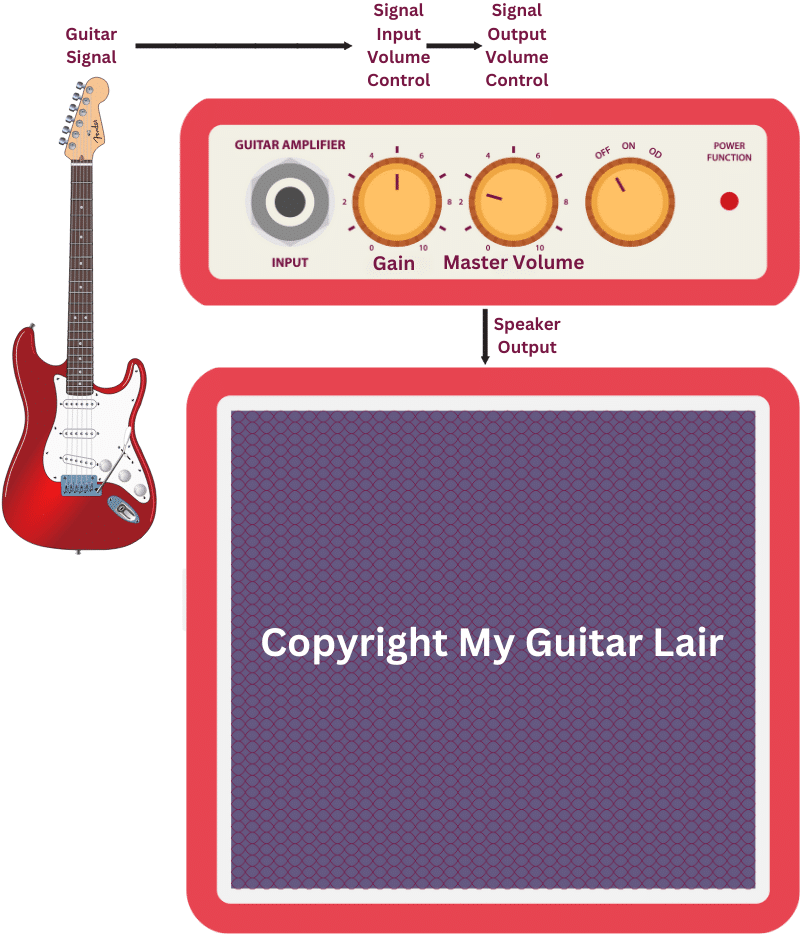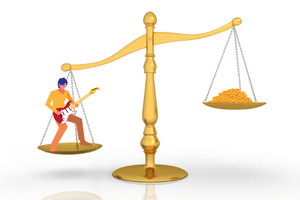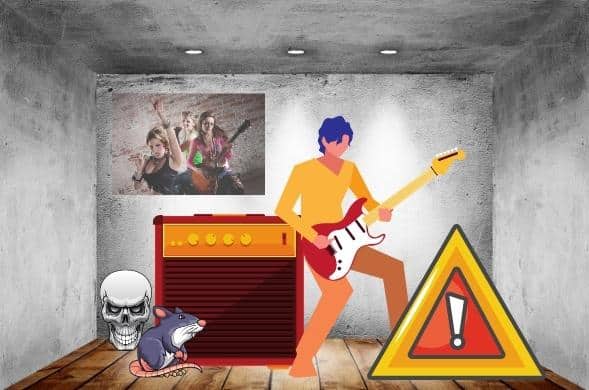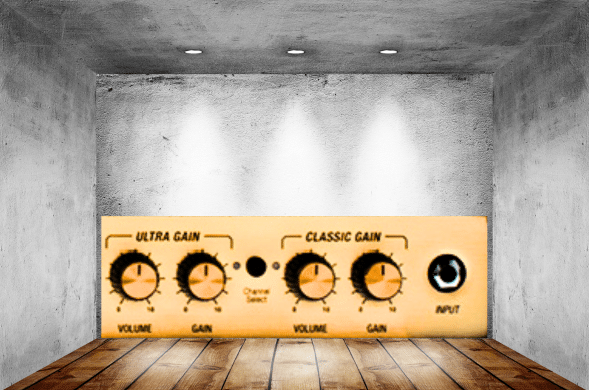Hello, fellow string strummers and sound aficionados! Have you ever wondered, “Is your guitar amp gain too high?” If the answer is yes, then you’re in the right place. Let’s dive into this topic together and make some noise – the right kind of noise!
If you are in a hurry, you can click here for info on troubleshooting your amp settings.
You can use the table of contents below to take you to the area that interests you. Click on the little box to open it and then click on the section of the article you want to read, or you can read from start to finish if you want the full amp gain experience!
The Short Answer
Unwanted noise, feedback, or a lack of clarity and definition in your guitar notes could indicate that your amp’s gain is too high. This might result in a muddy and indistinct tone. High gain settings can also cause all notes to have a similar level of distortion, regardless of how hard or soft you play.
Keep On Reading (Below) To Learn More
What Is “Gain?”
To start, let’s define what we mean by “gain” in simple terms.
Essentially, gain refers to the amplification level applied to an audio signal to increase its strength. This is measured in decibels (dB) and refers to the difference in signal strength between its input and output. A higher gain results in a stronger (louder) signal.
So, your guitar’s audio signal “gain” is adjusted in the pre-amp section of your guitar amplifier. It’s the first point of the signal boost and dramatically impacts your overall sound. Too much gain and your tone might turn into a distorted, muddy mess. Too little, and you might not hear much of anything at all!
If you’ve been dealing with sound issues lately and can’t figure out the culprit, chances are your amp gain could be set too high. Excessive gain can lead to an overdriven, overly distorted sound that lacks the clarity and dynamics you’re after.
Pros And Cons Of Gain


Here are ways to use gain in your playing and some of the things to avoid.
| Pros | Cons |
|---|---|
| Versatility in tone: Gain allows for a wide range of tones, from clean to crunchy to heavily distorted. | Potential for noise: High gain settings can introduce unwanted noise, static, and hiss, particularly on lower-quality amps. |
| Dynamic response: Gain interacts with your playing dynamics. Play harder for more distortion, softer for less. | Loss of definition: Too much gain can cause notes to lose definition, blend together, and become “muddy.” |
| Expressiveness: Gain adds sustain to your notes, making it great for solos and expressive playing. | Feedback issues: High gain can increase the likelihood of feedback, especially at high volumes or when close to the speaker. |
| Essential for certain genres: Gain is crucial for achieving the tones required in certain genres like Rock, Metal, Blues, and Punk. | Masks playing nuances: Excessive gain can mask subtle nuances in your playing and the unique tonal characteristics of your guitar. |
| Creates exciting live sound: High gain can create a powerful, energetic sound for live performances. | Difficult to control in a live setting: High-gain settings can be difficult to manage in a live setting, particularly when playing with other instruments. |
| Ability to match volume levels: Gain can be used to match the volume levels between guitars with different output levels. | Requires more power: High gain settings require more power from your amp, which can lead to quicker wear and tear. |
| Essential for sound shaping: Gain is an integral part of shaping your overall sound and character. | Can lead to tone chasing: With the availability of gain, guitarists might find themselves continuously tweaking settings in search of the perfect tone, sometimes overlooking the importance of technique. |
It’s crucial to remember that while gain is an essential part of achieving your desired tone, it’s not the only factor. The guitar, the amp, the speakers, the room, and most importantly, your playing style and technique all contribute to the final sound.
Keep On Reading (Below) To Learn More About Each Topic
How Is Gain Different From Master Volume?
That’s an excellent question! In the world of guitar amps, gain and master volume are two terms that often confuse beginners, and for a good reason. After all, both deal with how loud your guitar sounds, right? Well, yes, but not quite the same way. Let’s delve into the details.
Here is an illustration that shows how the Gain and Master Volume controls of a guitar amplifier function.
- An audio signal from a guitar enters the pre-amp section of a guitar amp.
- The signal strength is increased or decreased by adjusting the gain knob.
- The pre-amp signal is sent to the next section (stage) of the amplifier, where the signal’s overall loudness is adjusted with the Master Volume knob.
- The final amplified audio signal is sent to the speaker and is broadcasted into the air.

Gain
As I mentioned earlier, gain is the difference in strength between the signal the pre-amp stage receives from your guitar and its output to the amplification stage. Think of it as the input volume or the “sensitivity” of your amp.
The gain control acts as the first stage of your amplifier’s volume. The more gain you dial in, the harder the preamp section of your amplifier works, resulting in a more distorted or ‘crunchy’ tone. It’s the gain that’s primarily responsible for the character of your distortion.
Master Volume
On the other hand, the master volume controls the output of your amplifier. It is the overall volume that your amp puts out to your speakers, taking the signal that’s been shaped by the preamp (and affected by the gain setting) and controlling how loudly that signal is projected by the power amp.
Master volume doesn’t affect your tone in the same way that gain does. It’s more about how loud your amp is in the room. If you’ve set your gain and EQ to dial in your perfect tone at a low volume, you can use the master volume to crank up the volume for a gig without drastically altering that tone.
The Relationship Between Gain And Master Volume

So, if gain controls the level of your input signal and thus the amount of distortion, and master volume controls the overall loudness of the amp, how do they interact? Striking the right balance between the two is crucial to achieving a great guitar tone at any volume.
If you’re looking for a clean tone, you’d generally set your gain lower and your master volume higher. If you’re after a distorted tone, you might crank the gain up and adjust the master volume to an acceptable level.
Remember, every amp is different, and the gain and master volume controls will interact with each other differently depending on the amp’s design. The key is to spend time with your gear, understand how these controls interact, and find the settings that give you the sound you love.
In a nutshell, while gain and master volume both affect the loudness of your guitar, they do it at different stages and in different ways, giving you a great deal of control over your tone and volume. That’s the beauty of the electric guitar – you have the tools to shape your sound exactly how you want it!
How To Tell If Amp Gain Is Too High?
There are a few telltale signs. First and foremost, you’ll notice a loss of tonal clarity. Overdriven guitar sounds can be beautiful, but it’s time to reassess if all your notes are starting to blend into a sonic soup.
Next, pay attention to your amp’s responsiveness. If you’re playing softly, but your amp is still pushing out a roaring sound, your gain could be set too high. A well-set gain allows for dynamic control – the harder you play, the louder and possibly grittier the sound should be.
Finally, consider the overall volume coming from your amp. Your gain might need adjusting if your amp is too loud, even at low-volume settings. Remember, gain is not volume. If you’re trying to get louder by cranking up the gain, you’re doing it wrong.
Dialing In The Perfect Amount Of Gain

Dialing in the perfect guitar tone is a bit like baking the perfect cake; it requires the right balance of ingredients. For your guitar amp, those ingredients are Gain, Volume, and EQ (bass, middle, treble).
Here’s the way I dial in the right gain setting:
- Start with everything at zero. Set your amp’s volume, EQ, and gain all to zero.
- Slowly turn up the volume. Increase your amp’s volume to a comfortable level, where you can clearly hear what you’re playing without shaking the walls.
- Adjust the gain. Now, start increasing the gain until you reach a point where the sound starts to break up or distort. This point is the edge of your amp’s clean tone. Depending on the music you play, you might want to dial the gain a bit past this point for some grit, or keep it just under for a clean tone.
- Tweak the EQ. Now that you’ve set your gain and volume, play around with the EQ settings to shape your tone. Every guitar and amp will have its sweet spot – that perfect blend of bass, middle, and treble.
And there you have it, the recipe for a well-balanced sound! Remember, these are just starting points; everyone’s taste in tone varies.
Don’t Forget About Your Guitar’s Controls & Pickups!
Your guitar’s volume and tone controls are a vital part of the adjustment process. Dialing back your guitar’s volume can clean up an overdriven amp, adding yet another layer of dynamic control to your playing.
Try adjusting them while keeping your amp settings constant. You’ll be surprised at the range of tones you can achieve with this simple trick.
Some pickups may have a much higher output than others. For example, some Strats have a humbucker pickup in the bridge position and single-coil pickups in the middle and neck positions. By selecting the bridge position, this setup makes it easy to increase the amp’s gain when playing guitar solos.
A hot humbucker will drive an amp harder than a vintage-style single-coil, so remember to consider your guitar when setting your gain.
Do Different Amps Need Different Gain Settings?
Yes, they do! Every amp has a distinct character, and what works great on one may not work well on another.
A vintage tube amp might start distorting with the gain knob barely past two, while a modern solid-state amp might stay clean way up past seven or eight.
So take the time to get to know your amp. Experiment with different settings and find what works for you and your gear.
It’s also worth mentioning the role of your guitar again in this mix. As stated above, different guitars have different output levels, mainly due to differences in their pickups.
Amplifiers Without A Gain Control
Not all guitar amplifiers have both a gain and a master volume control. For example, some smaller practice amps and vintage models only have one volume knob. So, how does that work?
In an amplifier with only one volume control, that knob essentially combines the roles of the gain and the master volume into one.
When you turn the volume up on these amps, you’re increasing the input gain, which drives the preamp harder, leading to more distortion. At the same time, you’re also making the amp louder overall.
In practice, this means that on an amplifier with a single volume control, you’ll get a cleaner sound at lower volumes, and as you crank the volume, your sound will become more distorted or overdriven.
This is similar to what happens when you turn up the gain on an amp with separate gain and volume controls, except you don’t have the option to adjust the loudness and the amount of distortion independently.
This is actually how a lot of the classic rock tones were achieved – guitarists would turn their amps up to ten to overdrive the preamp and power amp stages, resulting in a warm, natural distortion.
While this setup gives you less flexibility than having separate gain and master volume controls, there’s also a certain charm to its simplicity. It encourages you to use your guitar’s volume and tone controls more effectively and can even inspire a different approach to your playing.
Why A Flexible Amplifier Is Essential

A key aspect of a flexible guitar amplifier is its ability to interact effectively with different guitars and effects. Before you buy an amp, it’s always a good idea to hear how it reacts to your playing style.
Whether you’re a studio musician needing to dial in a specific tone for a recording, a touring artist who plays a wide range of venues, or a bedroom guitarist exploring different genres, a versatile amplifier can cater to all these needs.
It’s ok to get an amplifier that is a high-gain monster to perfectly nail one particular tone, but you might want to have a more flexible amp as a backup.
Key Takeaways

Here are some key takeaways that will help solidify your understanding of guitar amp gain.
Certainly! Here are ten key takeaways on the subject of guitar amp gain and overall tonal shaping:
- Understand Your Amp’s Design: Different amps have unique gain structures based on their design. Whether it’s a tube, solid-state, or digital amp can greatly influence how gain is applied.
- Tone Controls Interact with Gain: Your amp’s bass, mid, and treble controls interact with the gain and can change your distortion character.
- Effects Pedals Matter: The use of effects pedals before the amp can significantly affect how the gain stages react. Distortion, overdrive, or boost pedals can push the amp’s gain further.
- Guitar’s Volume Control Is Important: Your guitar’s volume control is another way to control the gain staging. Rolling back the volume can clean up the tone, even if the amp’s gain is set high.
- Speaker Influence: The speakers in your amplifier (or in your cabinet if you’re using a head and cab setup) also influence the sound. Different speakers can handle gain in different ways.
- Pickup Output Levels: The output level of your guitar’s pickups will interact with your amp’s gain. High-output pickups might push the gain harder than low-output ones.
- Silence can be Golden: Strategic use of gain can help emphasize the quieter moments in your music for greater dynamic impact.
- Amp Settings for Recording: The gain settings that work live might not work as well in a recording situation. Often, less gain is needed when recording.
- Influence of Venue Size: The size and acoustics of the venue you’re playing at can influence how your gain settings come across. You may need to adjust your gain based on the room.
- Importance of Listening Carefully: Developing your ear to recognize the sweet spot for gain on your particular amp is vital. Understanding how gain affects your tone by listening can help you dial in your perfect sound faster.
Frequently Asked Questions

Here are some of the questions I get asked about guitar amp gain.
If your question does not appear here, please put it in the comments, and I will get right back to you with an answer.
Can Amp Gain Be Too Low?
It depends on the style of music you play. A gain setting that is too low can decrease note dynamics and sustain.
Does Gain Affect Background Noise?
Yes, increasing the gain can increase background noise. This can be problematic when note clarity is essential.
How Can I Reduce Noise At High Gain Settings?
Noise gates or suppressors can help. Also, quality cables and a good setup can reduce the noise.
Can High Gain Damage My Guitar Amp?
While using high gain won’t directly damage your amp, it can cause faster wear and tear on tubes in a tube amp over time. Ensuring your speakers are rated to handle the extra volume is also important.
How Does Gain Affect Sustain On My Guitar?
More gain can lead to more sustain, as the signal is amplified and the notes are held longer.
How Do I Balance Gain With EQ Settings?
Start with a neutral EQ, adjust the gain for the right amount of distortion, then fine-tune the EQ to shape your tone.
How Does Gain Work In A Tube Amp Vs. A Solid-State Amp?
Tube amps usually produce a natural, warm distortion as the gain increases, while solid-state amps may have a harsher, more digital-sounding distortion.
Does The Gain Setting Affect My Guitar’s Clean Tone?
Yes, even for clean tones, a small amount of gain can add warmth and fullness. Too much gain, though, will introduce distortion.
Final Thoughts

So, is your guitar amp gain too high? Perhaps. But now you’re equipped with the knowledge to assess and address the situation, fine-tuning your amp for that sweet spot.
Gain is measured in decibels (dB) and refers to the difference in signal strength between its input and output. A higher gain results in a stronger (louder) signal.
Understanding the pros and cons of using Gain and how it differs from master volume is essential for making your amp work well with your guitar and effects pedals.
Not all guitar amplifiers have both a gain and a master volume control. So, when you turn the volume up, you’re increasing the input gain while also making the amp louder overall.
It’s essential to have an amp flexible enough to handle all the musical styles you play. Before buying an amp, it’s a good idea to plug in your guitar and put it through its musical paces.
Remember, it’s all about balance and finding a sound that you love. The most important thing is that you enjoy the tone you’re getting, and it inspires you to pick up your guitar and play. After all, making music is all about joy. Happy playing, everyone!

Here’s a great video from The Studio Rats that demonstrates how to dial in your guitar amplifier gain. Be sure to check it out!
What To Read Next ➡ Is 50 Watts Enough Headroom For A Guitar Amp? – Full Guide!
Related Article ➡ How To Get More Sustain On Clean Tone – Pro Insider Tips!
Tell Me What You Think

Please leave a comment below if you enjoyed this article, have any questions about guitar amp gain or want to give your point of view. I will be happy to help you.
- Do you prefer an amp with a Gain and Master Volume control or a single Volume knob?
- What is your procedure for adjusting the gain on your amp?
- Have you found an amp flexible enough to handle all your low and high-gain needs?
- What else is on your mind?



Excellent article, Frank! It’s essential for guitarists to understand the impact of gain settings on their tone. Your article provides a clear explanation of what gain is, its pros and cons, and how it differs from master volume. The tips you provide on dialing in the perfect amount of gain are very useful, as are the insights on the interaction between different amps and guitars. Overall, this is a comprehensive and well thought out guide for guitarists looking to master and perfect their tone. Keep up the great work, and thanks for the content.
Hi, Kris
I appreciate your comments and am happy you found the article helpful!
Let me know if you have any specific questions regarding the gain adjustment on your amp.
Rock On! 🤘
Frank 🎸
Great article! Gain is such a crucial aspect of guitar tone, and it’s important to find the right balance to achieve the sound you’re after. The pros and cons you listed provide a clear overview of how gain can affect your playing experience. I also appreciate the explanation of the difference between gain and master volume, as they play distinct roles in shaping the overall sound. The tips on how to tell if your gain is too high and how to dial in the perfect amount of gain are very helpful for guitarists looking to optimize their tone. Overall, this article offers valuable insights into mastering guitar amp gain and achieving the desired sound. Well done!
Hi, Jason
Thank you for your comments!
What is your favorite amp, and how goes “gain” factor into your choice? 😎
Rock On! 🤘
Frank 🎸